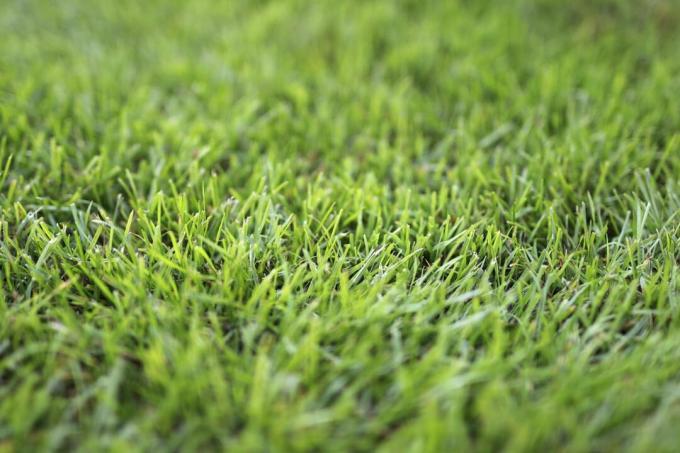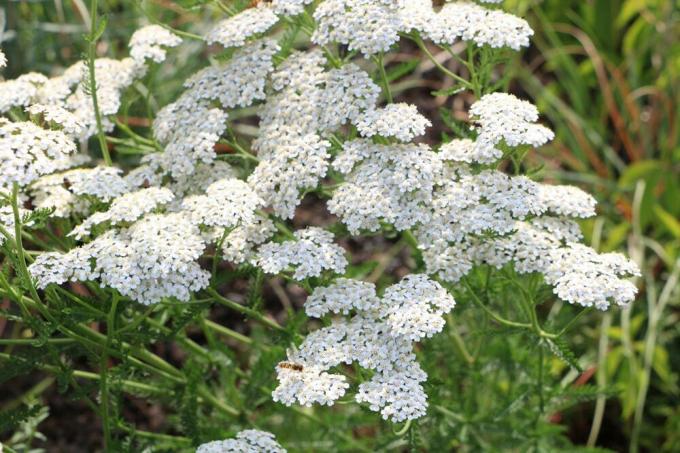

Table of contents
- Good time for reseeding
- Prepare overseeding and sow properly
- Other lawn care in September and October
- More tips
You can also use the time from September and October to carry out repair work so that your lawn looks even more beautiful next spring:
Good time for reseeding
If your lawn would benefit from growth, you should use the autumn for reseeding. Partial reseeding should become an annual habit for every lawn owner once the lawn is a few years old. Because the lawn grasses are perennial, so they die after a few years. In addition, a lawn can of course suffer from drought damage during a hot summer, sometimes causing even larger gaps.
Autumn is an excellent time for reseeding, because then the grasses can germinate first and then have a long period of rest ahead of them for the roots to form and consolidate can. However, you must give the new seeds the chance to develop sufficiently by the winter. It is therefore best to reseed immediately after the heat wave is over. As a rule, it can be reseeded around the beginning of September.
If you decide to overseed, you should either use a special overseeding mix for the bare patches or take the opportunity to change the composition of your lawn. This is useful when you're dealing with lawn plants that don't actually exactly match the use they're actually going to be exposed to. Then you could use a standard seed mixture for overseeding, which guarantees you that the the lawn that will sprout from the over-seeding will have exactly the properties you want from your lawn demand.
As checked standard seed mix (RSM) you can purchase special seeds for recreational lawns, hard-wearing lawns or ornamental lawns, each with several subspecies. If you have other wishes for your lawn: There are several other varieties. If the existing lawn has only a few gaps, you would need to inquire about the varieties that fit under these Conditions are suitable for reseeding – not every lawn seed will grow well in densely rooted areas at.
Prepare overseeding and sow properly
In any case, the soil must be prepared for reseeding in such a way that the seed has good contact with the soil. It should be covered easily. Lawn seed does not need light to germinate and is then also protected from drought and bird damage. You should therefore not simply throw the seed onto the turf, but scrape the soil lightly beforehand and only then scatter the seed. The best way to do this is to scarify beforehand, so that the superfluous old material is removed immediately. If you then mow the lawn very short, the existing lawn will become more competitive weakened, so that the reseeding has a good chance (in addition, the residues from scarifying are removed at the same time recorded).
However, if you overseed another type of lawn, be aware that your lawn will appear slightly "blotchy" because the overseeding produces grasses of a different color. However, if you can improve the quality of the lawn by doing so, it is best to just accept it You will hardly notice it when mowing and then probably not at all after the next reseeding of your “dream seed mixture”. more.
Even when sowing special reseeding mixtures, there are "stains", in the experience of many lawn owners even to a greater extent, because these reseeding mixtures mainly contain varieties that germinate and grow particularly quickly, regardless of their suitability.
Other lawn care in September and October
If the lawn has not yet received its autumn fertilization in August, you should apply a potassium-rich final fertilization in October. If your lawn gets a lot of potassium now, it will be well equipped to withstand the cold and drought in winter, and it can also resist fungal infestation.
Once the leaves start falling, it definitely should leaves removed from the lawn become. The lawn does not like being smothered and shaded under the foliage at all. With the heaps of leaves on the lawn, the risk of colonization by fungi, which love the climate under the leaves, also increases. It is usually sufficient if you pick up the leaves when mowing the lawn, only if you have a lot of trees in the garden should you occasionally use a rake.
You can use the raked leaves for mulching, i.e. spread them under the trees as natural fertilizer, or of course you can also compost them. In the absence of a compost heap, you are doing small mammals and insects a favor by piling up the leaves in a corner of the garden - they will happily hibernate in the heap.
When the last cut is due depends on growth and weather. In any case, you will have to mow until the end of October. The cut may be slightly shorter than in midsummer (cut with the highest lawn height), because no shade is needed more (quite the opposite, your lawn now needs all the light it can get). The last cut of the year can also be much later. With nice weather, your lawn will grow well into the winter, especially in warmer areas.
Also with regard to watering, you should not say goodbye to the winter break too early: September counts for the Lawns in the driest months, even later in the year it can still get so dry that the lawn waters out of the sprinkler needs.
More tips
- Now is also the time to give your lawnmower a little attention before it goes on winter break. On motor mowers, the spark plug connector should be pulled before maintenance work. Then you can work without the engine being able to start. You should thoroughly remove any debris from the housing, blade and wheels, then the mower is lubricated from the inside and outside, the metal parts are treated with anti-rust agents good.
- Potassium fertilization has already been recommended above. You should definitely not fall your usual Slow-release lawn fertilizer out, as this would really stimulate the growth of the lawn again, but this is not beneficial is: The lawn would go into the winter with soft, thin grasses that are very susceptible to frost and disease would be.
- When you mow now, you should not allow the lawn to be lower or higher than the recommended normal lawn height. Cut very short, leaving the soil just a little more exposed to frost which can now more easily penetrate the root zone. If you let the lawn stand higher, frozen grasses may tip over, killing the grasses growing underneath, leaving the lawn with gaps in the spring. Rather, the lawn should start the winter at exactly the same height as it was during the season.
 garden editorial
garden editorial I write about everything that interests me in my garden.
Learn more about lawn care

Sanding the lawn: how much sand per m²?
The lawn is the focal point of the garden. Sanding the lawn can effectively influence its appearance. However, there are a few things to consider, because too much of it can also damage the green. Read here how much sand you should apply per m² when sanding the lawn.

Overseed the lawn without scarifying?
Which hobby gardener doesn't dream of a dense, lush green lawn? Bald spots not only look unsightly, they also encourage weed growth. But can you overseed a lawn without scarifying it first?

Recognize and fight couch grass successfully | 10 tips
Couch grass is one of the most stubborn weeds. However, there are also differences here, because not every species becomes a problem in the garden. However, if the creeping or common couch grass is up to mischief, you can take action against it with perseverance and the right techniques.

Iron fertilizer: the right use in the lawn
Iron fertilizer supplies the lawn and works against moss. However, it has to be used correctly. Therefore, observe the following tips to achieve optimal results for the grass plants and to avoid damage to the meadow.

Does coffee grounds help against clover in the lawn?
Clover in the lawn is a nuisance that many garden owners struggle with. Lawns, which in some cases are interspersed with numerous nests, are often affected. As an alternative to chemical agents, many wonder whether coffee grounds are effective against weeds.

Yarrow in the lawn | How do I get rid of yarrow?
There is no question that yarrow is one of the best-known medicinal herbs. It helps against colds and is used for skin diseases and gynecological problems. On the manicured lawn, she is seen as a troublemaker. How do you get rid of them? Are there effective alternatives to the chemical club?



